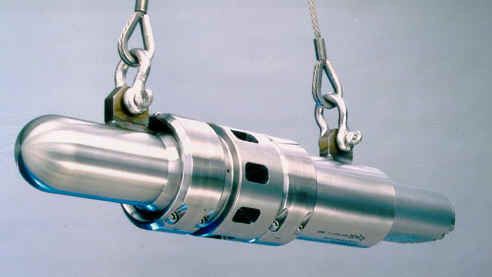Perhaps one of the more salient benefits of our work on ocean noise pollution is that unlike solid and chemical pollution, when the noise goes away, it is gone. This gives us reasons for optimism, particularly as we see efforts to improve technologies and practices by a broadening base of ocean stakeholders.
The first inkling that this could happen occurred a few years back when the United Nations International Maritime Organization (IMO) issued guidelines for the quieting of ocean vessels.
Just this year the “International Quiet Ocean Experiment” brought together scientists and stakeholders to craft a cooperative plan for understanding and mitigating the impacts of human generated noise in the ocean.

Bolt Airgun
And just this month three items came across the boards. An article in Sea Technology about Ultra Electronics Sonar Systems developments of a biomimetic sonar that uses biologically derived signals instead of synthetic or digital signals. The article examines the relative effectiveness of sperm whale echolocation clicks against synthetic signals, but it also suggests that animals would be less threatened by signals that are “natural sounding” and thus less likely to respond negatively.

Seismic Survey Array
In the same issue there is another article about the benefits of using continuous sonar signals as opposed to periodic blasts. Typical surveillance and navigation sonars kick out a blast or “ping” and waits for an echo to return off of a target. By using some advanced integration techniques the continuously active sonar can lock on to a target and track it using an equivalent amount of energy but spread over time – allowing for a decreased source level and potentially less impacts on marine life.
The third piece coming across my desk was in a local newsletter from Norwalk CT, where the seismic airgun manufacture Bolt Technologies is collaborating with Schlumberger on limiting the bandwidth and thus quieting down the collateral noise from seismic airguns. In an ideal setting the seismic signals would sound less like “bangs” and more like waves crashing, which again sounds more “natural” and should also decrease the impacts on marine life.
I spoke with John Andros with Bolt today, and while the actual product is not ready for prime time yet, they wanted to announce the project and the collaboration.
It is nice to know that some big stakeholders are taking this noise issue to heart. If we continue to move forward, pernicious ocean noise pollution could end up being “a thing of the past.”

I was speaking with John Diebold a few years back – who had been in the geophysical survey business since the 1970’s. He said that the early surveys used to amount to tossing sticks of dynamite overt the transom and reading the return. They knew they were doing damage because the survey vessel was followed by a wake of dead fish that floated up to the surface after the blasts. Yet earlier, the use of “black powder” didn’t seem to harm the fish. The difference between these two explosions is in the rise time – dynamite being perhaps ten times faster – packing the same energy into a shorter amount of time and thus doing much more damage.
Regardless of attenuated high frequency output of the airguns, at the end of the day one should determine if the rise time and peak pressures have decreased with the use of this new airgun technology. These are the properties that have potential to create the greatest amount of physical damage.